IT Service Management Report: Queensland Healthcare Analysis
VerifiedAdded on 2021/04/24
|15
|2993
|33
Report
AI Summary
This report provides a detailed analysis of IT Service Management (ITSM) within Queensland healthcare, focusing on the implementation of the ITIL framework. It begins by outlining the challenges and breakthroughs encountered during the initial implementation attempts, including issues with resource allocation, change management, and the integration of existing quality management systems. The report then delves into service strategy fundamentals, emphasizing customer relationship management, vendor management, IT service continuity, and availability management. It explores service model design, ITIL service lifecycle components, and service operation. A summary of literature review is provided, highlighting the importance of senior management commitment and the need for a strategic approach to ITIL adoption. Finally, the report outlines support planning processes, covering project initiation, coordination, and planning to ensure successful ITSM implementation.

Running head: IT SERVICE MANAGEMENT
IT Service Management
Name of the Student
Name of the University
Author Note
IT Service Management
Name of the Student
Name of the University
Author Note
Paraphrase This Document
Need a fresh take? Get an instant paraphrase of this document with our AI Paraphraser
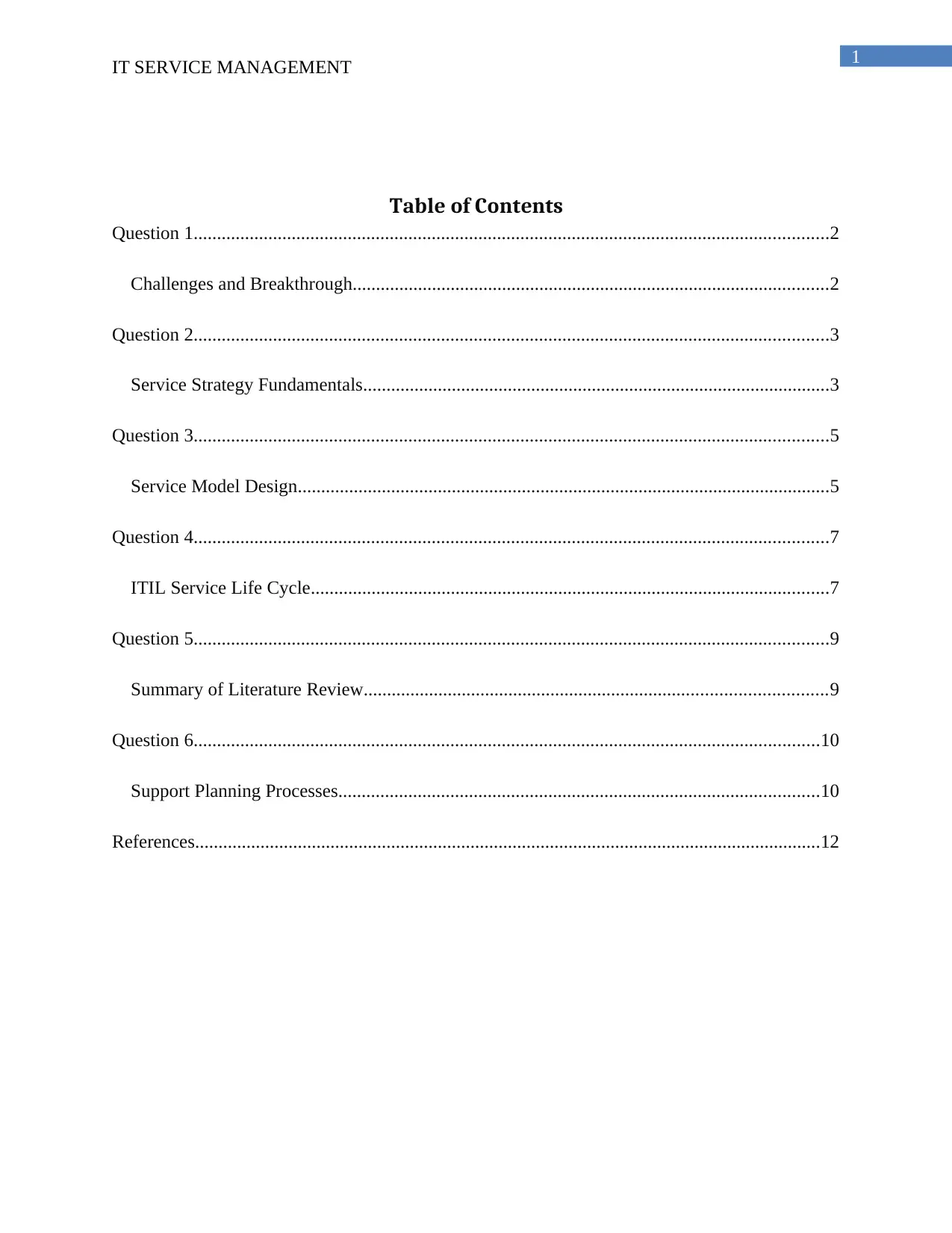
1
IT SERVICE MANAGEMENT
Table of Contents
Question 1........................................................................................................................................2
Challenges and Breakthrough......................................................................................................2
Question 2........................................................................................................................................3
Service Strategy Fundamentals....................................................................................................3
Question 3........................................................................................................................................5
Service Model Design..................................................................................................................5
Question 4........................................................................................................................................7
ITIL Service Life Cycle...............................................................................................................7
Question 5........................................................................................................................................9
Summary of Literature Review...................................................................................................9
Question 6......................................................................................................................................10
Support Planning Processes.......................................................................................................10
References......................................................................................................................................12
IT SERVICE MANAGEMENT
Table of Contents
Question 1........................................................................................................................................2
Challenges and Breakthrough......................................................................................................2
Question 2........................................................................................................................................3
Service Strategy Fundamentals....................................................................................................3
Question 3........................................................................................................................................5
Service Model Design..................................................................................................................5
Question 4........................................................................................................................................7
ITIL Service Life Cycle...............................................................................................................7
Question 5........................................................................................................................................9
Summary of Literature Review...................................................................................................9
Question 6......................................................................................................................................10
Support Planning Processes.......................................................................................................10
References......................................................................................................................................12
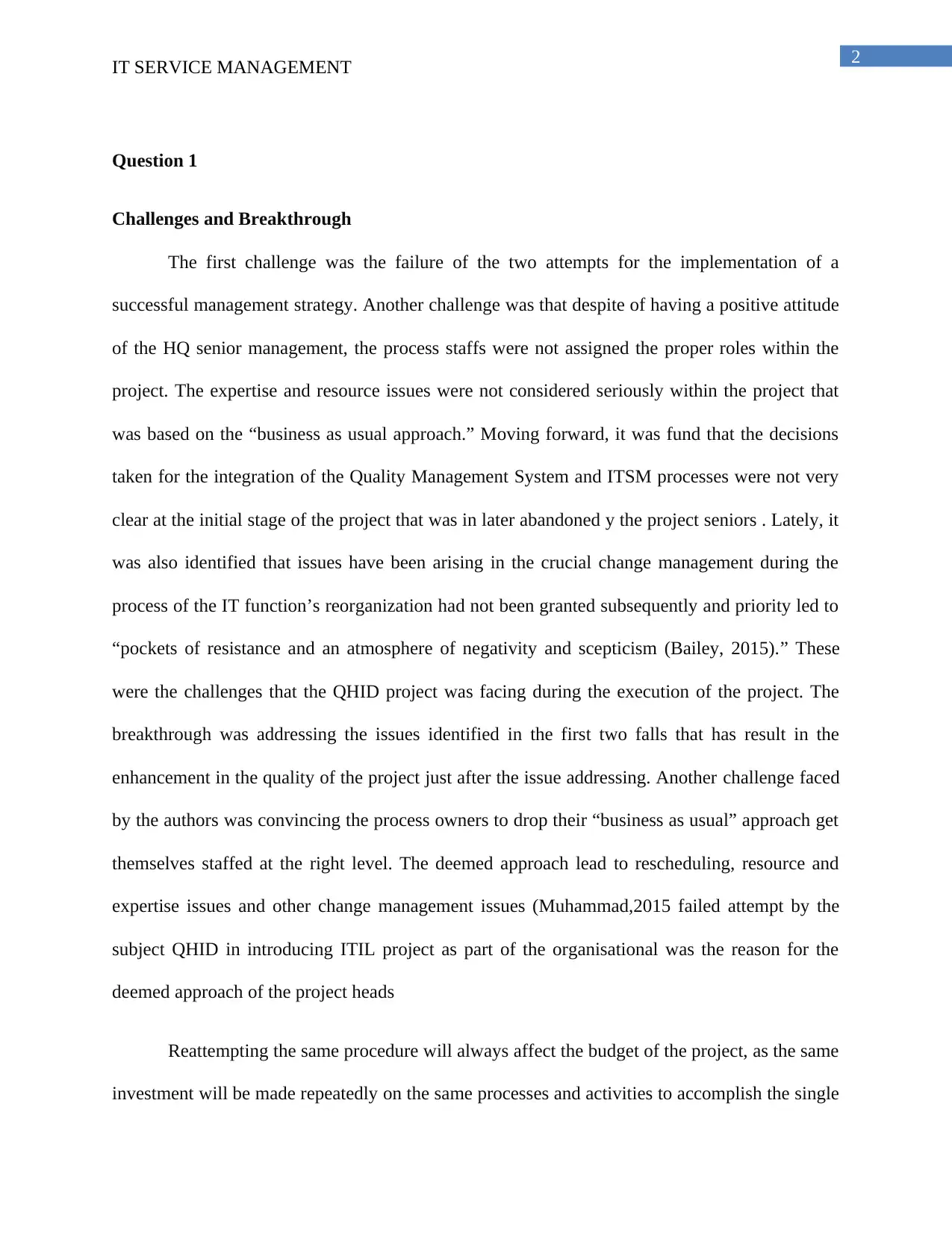
2
IT SERVICE MANAGEMENT
Question 1
Challenges and Breakthrough
The first challenge was the failure of the two attempts for the implementation of a
successful management strategy. Another challenge was that despite of having a positive attitude
of the HQ senior management, the process staffs were not assigned the proper roles within the
project. The expertise and resource issues were not considered seriously within the project that
was based on the “business as usual approach.” Moving forward, it was fund that the decisions
taken for the integration of the Quality Management System and ITSM processes were not very
clear at the initial stage of the project that was in later abandoned y the project seniors . Lately, it
was also identified that issues have been arising in the crucial change management during the
process of the IT function’s reorganization had not been granted subsequently and priority led to
“pockets of resistance and an atmosphere of negativity and scepticism (Bailey, 2015).” These
were the challenges that the QHID project was facing during the execution of the project. The
breakthrough was addressing the issues identified in the first two falls that has result in the
enhancement in the quality of the project just after the issue addressing. Another challenge faced
by the authors was convincing the process owners to drop their “business as usual” approach get
themselves staffed at the right level. The deemed approach lead to rescheduling, resource and
expertise issues and other change management issues (Muhammad,2015 failed attempt by the
subject QHID in introducing ITIL project as part of the organisational was the reason for the
deemed approach of the project heads
Reattempting the same procedure will always affect the budget of the project, as the same
investment will be made repeatedly on the same processes and activities to accomplish the single
IT SERVICE MANAGEMENT
Question 1
Challenges and Breakthrough
The first challenge was the failure of the two attempts for the implementation of a
successful management strategy. Another challenge was that despite of having a positive attitude
of the HQ senior management, the process staffs were not assigned the proper roles within the
project. The expertise and resource issues were not considered seriously within the project that
was based on the “business as usual approach.” Moving forward, it was fund that the decisions
taken for the integration of the Quality Management System and ITSM processes were not very
clear at the initial stage of the project that was in later abandoned y the project seniors . Lately, it
was also identified that issues have been arising in the crucial change management during the
process of the IT function’s reorganization had not been granted subsequently and priority led to
“pockets of resistance and an atmosphere of negativity and scepticism (Bailey, 2015).” These
were the challenges that the QHID project was facing during the execution of the project. The
breakthrough was addressing the issues identified in the first two falls that has result in the
enhancement in the quality of the project just after the issue addressing. Another challenge faced
by the authors was convincing the process owners to drop their “business as usual” approach get
themselves staffed at the right level. The deemed approach lead to rescheduling, resource and
expertise issues and other change management issues (Muhammad,2015 failed attempt by the
subject QHID in introducing ITIL project as part of the organisational was the reason for the
deemed approach of the project heads
Reattempting the same procedure will always affect the budget of the project, as the same
investment will be made repeatedly on the same processes and activities to accomplish the single
⊘ This is a preview!⊘
Do you want full access?
Subscribe today to unlock all pages.

Trusted by 1+ million students worldwide
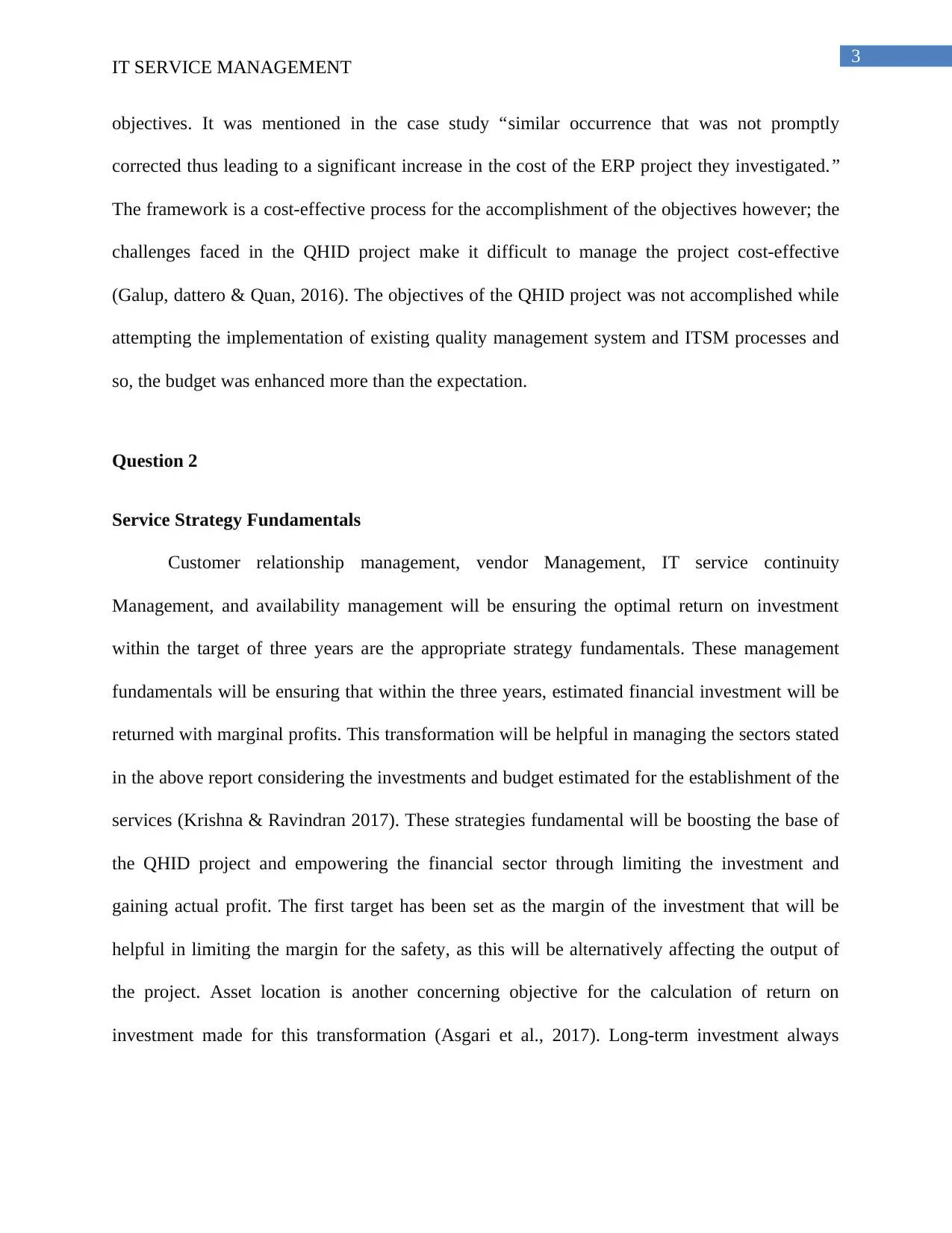
3
IT SERVICE MANAGEMENT
objectives. It was mentioned in the case study “similar occurrence that was not promptly
corrected thus leading to a significant increase in the cost of the ERP project they investigated. ”
The framework is a cost-effective process for the accomplishment of the objectives however; the
challenges faced in the QHID project make it difficult to manage the project cost-effective
(Galup, dattero & Quan, 2016). The objectives of the QHID project was not accomplished while
attempting the implementation of existing quality management system and ITSM processes and
so, the budget was enhanced more than the expectation.
Question 2
Service Strategy Fundamentals
Customer relationship management, vendor Management, IT service continuity
Management, and availability management will be ensuring the optimal return on investment
within the target of three years are the appropriate strategy fundamentals. These management
fundamentals will be ensuring that within the three years, estimated financial investment will be
returned with marginal profits. This transformation will be helpful in managing the sectors stated
in the above report considering the investments and budget estimated for the establishment of the
services (Krishna & Ravindran 2017). These strategies fundamental will be boosting the base of
the QHID project and empowering the financial sector through limiting the investment and
gaining actual profit. The first target has been set as the margin of the investment that will be
helpful in limiting the margin for the safety, as this will be alternatively affecting the output of
the project. Asset location is another concerning objective for the calculation of return on
investment made for this transformation (Asgari et al., 2017). Long-term investment always
IT SERVICE MANAGEMENT
objectives. It was mentioned in the case study “similar occurrence that was not promptly
corrected thus leading to a significant increase in the cost of the ERP project they investigated. ”
The framework is a cost-effective process for the accomplishment of the objectives however; the
challenges faced in the QHID project make it difficult to manage the project cost-effective
(Galup, dattero & Quan, 2016). The objectives of the QHID project was not accomplished while
attempting the implementation of existing quality management system and ITSM processes and
so, the budget was enhanced more than the expectation.
Question 2
Service Strategy Fundamentals
Customer relationship management, vendor Management, IT service continuity
Management, and availability management will be ensuring the optimal return on investment
within the target of three years are the appropriate strategy fundamentals. These management
fundamentals will be ensuring that within the three years, estimated financial investment will be
returned with marginal profits. This transformation will be helpful in managing the sectors stated
in the above report considering the investments and budget estimated for the establishment of the
services (Krishna & Ravindran 2017). These strategies fundamental will be boosting the base of
the QHID project and empowering the financial sector through limiting the investment and
gaining actual profit. The first target has been set as the margin of the investment that will be
helpful in limiting the margin for the safety, as this will be alternatively affecting the output of
the project. Asset location is another concerning objective for the calculation of return on
investment made for this transformation (Asgari et al., 2017). Long-term investment always
Paraphrase This Document
Need a fresh take? Get an instant paraphrase of this document with our AI Paraphraser
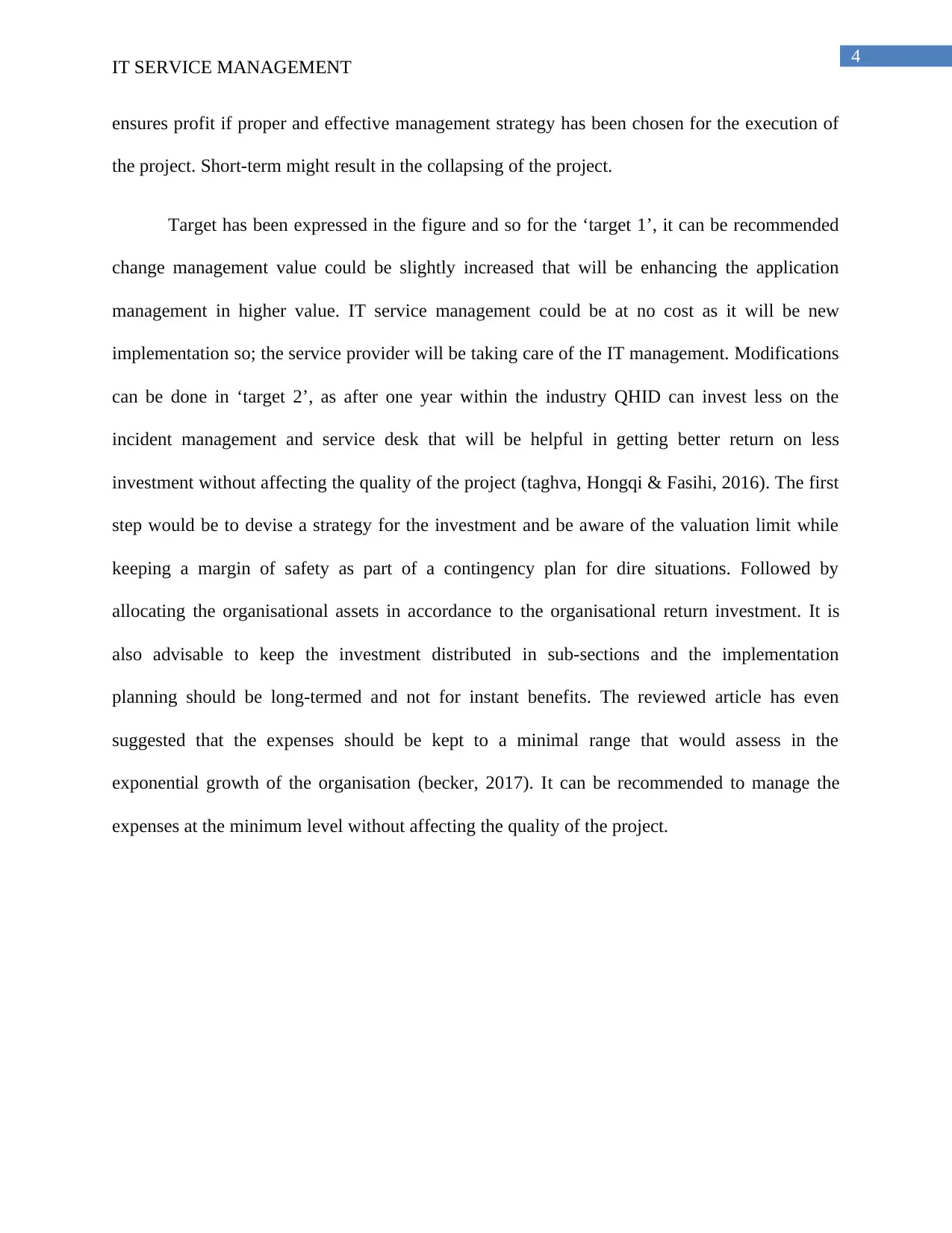
4
IT SERVICE MANAGEMENT
ensures profit if proper and effective management strategy has been chosen for the execution of
the project. Short-term might result in the collapsing of the project.
Target has been expressed in the figure and so for the ‘target 1’, it can be recommended
change management value could be slightly increased that will be enhancing the application
management in higher value. IT service management could be at no cost as it will be new
implementation so; the service provider will be taking care of the IT management. Modifications
can be done in ‘target 2’, as after one year within the industry QHID can invest less on the
incident management and service desk that will be helpful in getting better return on less
investment without affecting the quality of the project (taghva, Hongqi & Fasihi, 2016). The first
step would be to devise a strategy for the investment and be aware of the valuation limit while
keeping a margin of safety as part of a contingency plan for dire situations. Followed by
allocating the organisational assets in accordance to the organisational return investment. It is
also advisable to keep the investment distributed in sub-sections and the implementation
planning should be long-termed and not for instant benefits. The reviewed article has even
suggested that the expenses should be kept to a minimal range that would assess in the
exponential growth of the organisation (becker, 2017). It can be recommended to manage the
expenses at the minimum level without affecting the quality of the project.
IT SERVICE MANAGEMENT
ensures profit if proper and effective management strategy has been chosen for the execution of
the project. Short-term might result in the collapsing of the project.
Target has been expressed in the figure and so for the ‘target 1’, it can be recommended
change management value could be slightly increased that will be enhancing the application
management in higher value. IT service management could be at no cost as it will be new
implementation so; the service provider will be taking care of the IT management. Modifications
can be done in ‘target 2’, as after one year within the industry QHID can invest less on the
incident management and service desk that will be helpful in getting better return on less
investment without affecting the quality of the project (taghva, Hongqi & Fasihi, 2016). The first
step would be to devise a strategy for the investment and be aware of the valuation limit while
keeping a margin of safety as part of a contingency plan for dire situations. Followed by
allocating the organisational assets in accordance to the organisational return investment. It is
also advisable to keep the investment distributed in sub-sections and the implementation
planning should be long-termed and not for instant benefits. The reviewed article has even
suggested that the expenses should be kept to a minimal range that would assess in the
exponential growth of the organisation (becker, 2017). It can be recommended to manage the
expenses at the minimum level without affecting the quality of the project.
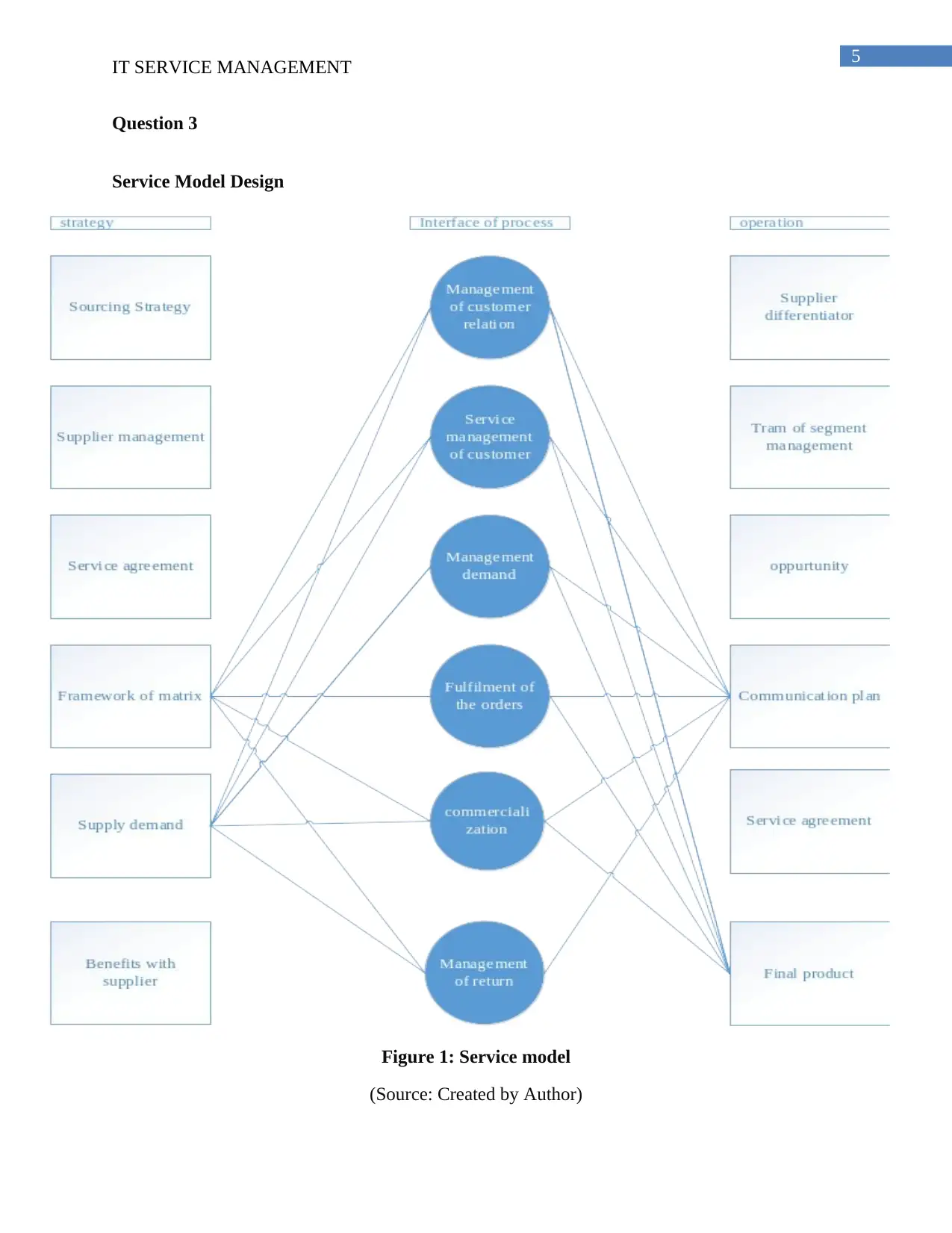
5
IT SERVICE MANAGEMENT
Question 3
Service Model Design
Figure 1: Service model
(Source: Created by Author)
IT SERVICE MANAGEMENT
Question 3
Service Model Design
Figure 1: Service model
(Source: Created by Author)
⊘ This is a preview!⊘
Do you want full access?
Subscribe today to unlock all pages.

Trusted by 1+ million students worldwide

6
IT SERVICE MANAGEMENT
Figure 2: Information system in Supplier Relationship Management
(Source: Created by Author)
IT SERVICE MANAGEMENT
Figure 2: Information system in Supplier Relationship Management
(Source: Created by Author)
Paraphrase This Document
Need a fresh take? Get an instant paraphrase of this document with our AI Paraphraser
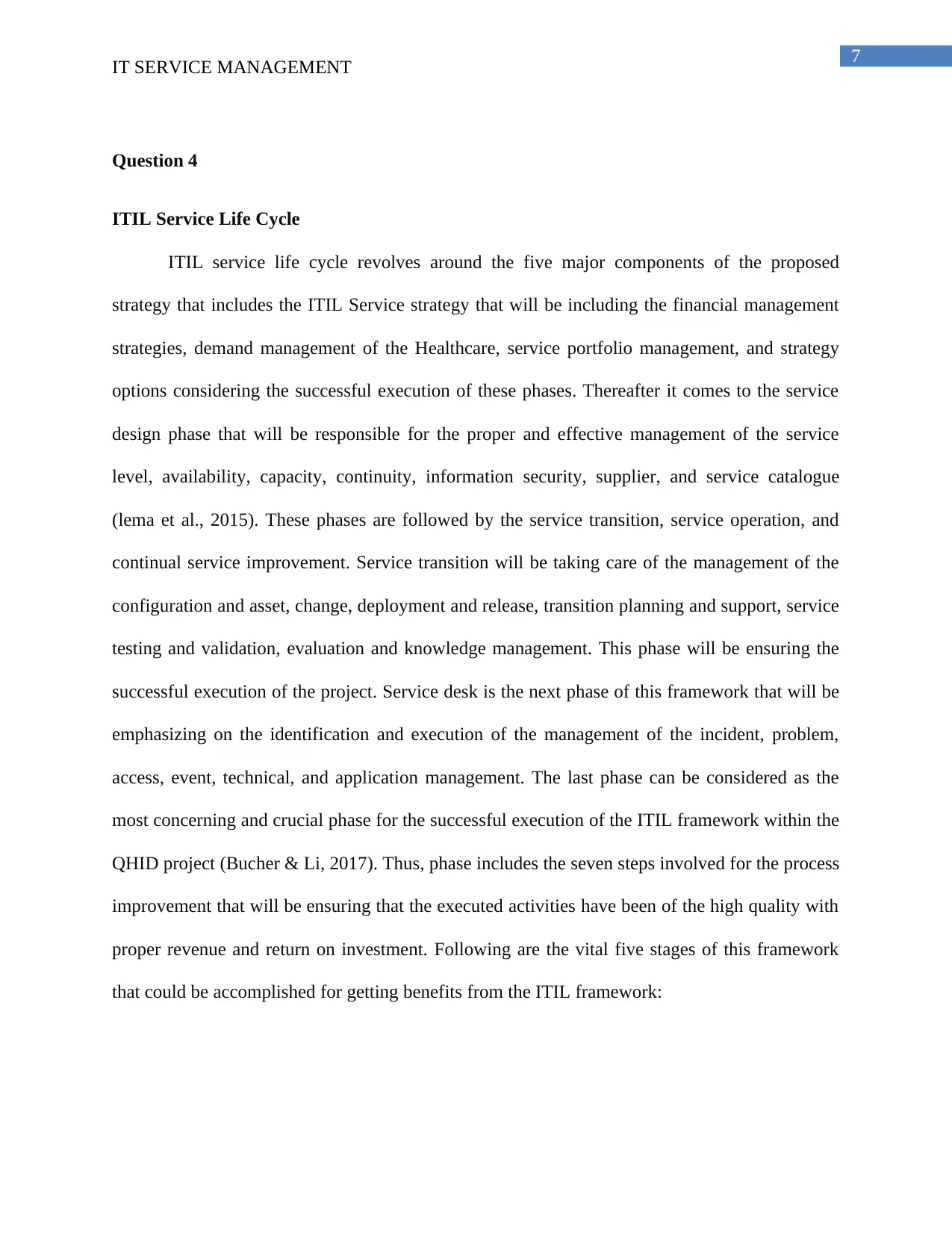
7
IT SERVICE MANAGEMENT
Question 4
ITIL Service Life Cycle
ITIL service life cycle revolves around the five major components of the proposed
strategy that includes the ITIL Service strategy that will be including the financial management
strategies, demand management of the Healthcare, service portfolio management, and strategy
options considering the successful execution of these phases. Thereafter it comes to the service
design phase that will be responsible for the proper and effective management of the service
level, availability, capacity, continuity, information security, supplier, and service catalogue
(lema et al., 2015). These phases are followed by the service transition, service operation, and
continual service improvement. Service transition will be taking care of the management of the
configuration and asset, change, deployment and release, transition planning and support, service
testing and validation, evaluation and knowledge management. This phase will be ensuring the
successful execution of the project. Service desk is the next phase of this framework that will be
emphasizing on the identification and execution of the management of the incident, problem,
access, event, technical, and application management. The last phase can be considered as the
most concerning and crucial phase for the successful execution of the ITIL framework within the
QHID project (Bucher & Li, 2017). Thus, phase includes the seven steps involved for the process
improvement that will be ensuring that the executed activities have been of the high quality with
proper revenue and return on investment. Following are the vital five stages of this framework
that could be accomplished for getting benefits from the ITIL framework:
IT SERVICE MANAGEMENT
Question 4
ITIL Service Life Cycle
ITIL service life cycle revolves around the five major components of the proposed
strategy that includes the ITIL Service strategy that will be including the financial management
strategies, demand management of the Healthcare, service portfolio management, and strategy
options considering the successful execution of these phases. Thereafter it comes to the service
design phase that will be responsible for the proper and effective management of the service
level, availability, capacity, continuity, information security, supplier, and service catalogue
(lema et al., 2015). These phases are followed by the service transition, service operation, and
continual service improvement. Service transition will be taking care of the management of the
configuration and asset, change, deployment and release, transition planning and support, service
testing and validation, evaluation and knowledge management. This phase will be ensuring the
successful execution of the project. Service desk is the next phase of this framework that will be
emphasizing on the identification and execution of the management of the incident, problem,
access, event, technical, and application management. The last phase can be considered as the
most concerning and crucial phase for the successful execution of the ITIL framework within the
QHID project (Bucher & Li, 2017). Thus, phase includes the seven steps involved for the process
improvement that will be ensuring that the executed activities have been of the high quality with
proper revenue and return on investment. Following are the vital five stages of this framework
that could be accomplished for getting benefits from the ITIL framework:
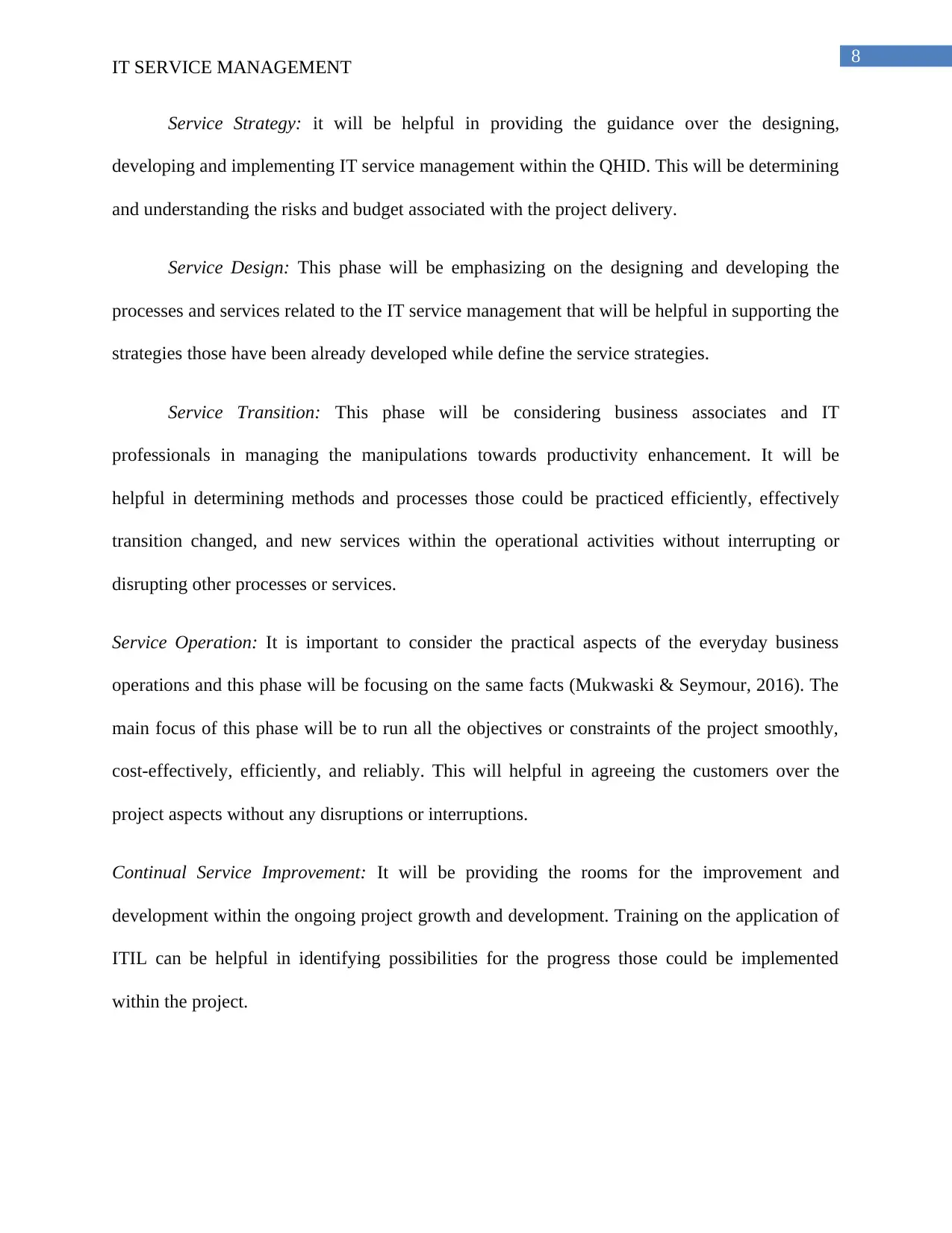
8
IT SERVICE MANAGEMENT
Service Strategy: it will be helpful in providing the guidance over the designing,
developing and implementing IT service management within the QHID. This will be determining
and understanding the risks and budget associated with the project delivery.
Service Design: This phase will be emphasizing on the designing and developing the
processes and services related to the IT service management that will be helpful in supporting the
strategies those have been already developed while define the service strategies.
Service Transition: This phase will be considering business associates and IT
professionals in managing the manipulations towards productivity enhancement. It will be
helpful in determining methods and processes those could be practiced efficiently, effectively
transition changed, and new services within the operational activities without interrupting or
disrupting other processes or services.
Service Operation: It is important to consider the practical aspects of the everyday business
operations and this phase will be focusing on the same facts (Mukwaski & Seymour, 2016). The
main focus of this phase will be to run all the objectives or constraints of the project smoothly,
cost-effectively, efficiently, and reliably. This will helpful in agreeing the customers over the
project aspects without any disruptions or interruptions.
Continual Service Improvement: It will be providing the rooms for the improvement and
development within the ongoing project growth and development. Training on the application of
ITIL can be helpful in identifying possibilities for the progress those could be implemented
within the project.
IT SERVICE MANAGEMENT
Service Strategy: it will be helpful in providing the guidance over the designing,
developing and implementing IT service management within the QHID. This will be determining
and understanding the risks and budget associated with the project delivery.
Service Design: This phase will be emphasizing on the designing and developing the
processes and services related to the IT service management that will be helpful in supporting the
strategies those have been already developed while define the service strategies.
Service Transition: This phase will be considering business associates and IT
professionals in managing the manipulations towards productivity enhancement. It will be
helpful in determining methods and processes those could be practiced efficiently, effectively
transition changed, and new services within the operational activities without interrupting or
disrupting other processes or services.
Service Operation: It is important to consider the practical aspects of the everyday business
operations and this phase will be focusing on the same facts (Mukwaski & Seymour, 2016). The
main focus of this phase will be to run all the objectives or constraints of the project smoothly,
cost-effectively, efficiently, and reliably. This will helpful in agreeing the customers over the
project aspects without any disruptions or interruptions.
Continual Service Improvement: It will be providing the rooms for the improvement and
development within the ongoing project growth and development. Training on the application of
ITIL can be helpful in identifying possibilities for the progress those could be implemented
within the project.
⊘ This is a preview!⊘
Do you want full access?
Subscribe today to unlock all pages.

Trusted by 1+ million students worldwide
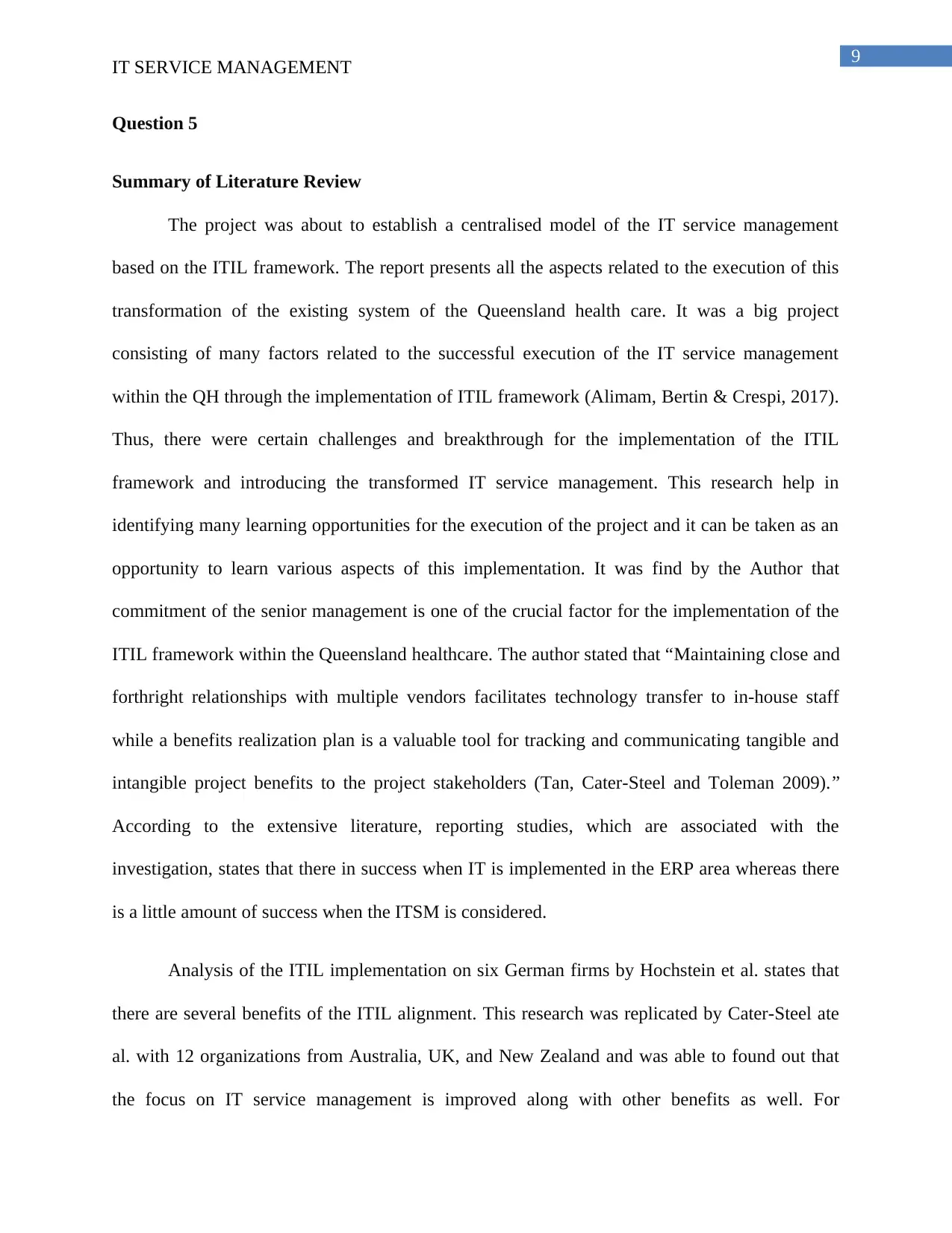
9
IT SERVICE MANAGEMENT
Question 5
Summary of Literature Review
The project was about to establish a centralised model of the IT service management
based on the ITIL framework. The report presents all the aspects related to the execution of this
transformation of the existing system of the Queensland health care. It was a big project
consisting of many factors related to the successful execution of the IT service management
within the QH through the implementation of ITIL framework (Alimam, Bertin & Crespi, 2017).
Thus, there were certain challenges and breakthrough for the implementation of the ITIL
framework and introducing the transformed IT service management. This research help in
identifying many learning opportunities for the execution of the project and it can be taken as an
opportunity to learn various aspects of this implementation. It was find by the Author that
commitment of the senior management is one of the crucial factor for the implementation of the
ITIL framework within the Queensland healthcare. The author stated that “Maintaining close and
forthright relationships with multiple vendors facilitates technology transfer to in-house staff
while a benefits realization plan is a valuable tool for tracking and communicating tangible and
intangible project benefits to the project stakeholders (Tan, Cater-Steel and Toleman 2009).”
According to the extensive literature, reporting studies, which are associated with the
investigation, states that there in success when IT is implemented in the ERP area whereas there
is a little amount of success when the ITSM is considered.
Analysis of the ITIL implementation on six German firms by Hochstein et al. states that
there are several benefits of the ITIL alignment. This research was replicated by Cater-Steel ate
al. with 12 organizations from Australia, UK, and New Zealand and was able to found out that
the focus on IT service management is improved along with other benefits as well. For
IT SERVICE MANAGEMENT
Question 5
Summary of Literature Review
The project was about to establish a centralised model of the IT service management
based on the ITIL framework. The report presents all the aspects related to the execution of this
transformation of the existing system of the Queensland health care. It was a big project
consisting of many factors related to the successful execution of the IT service management
within the QH through the implementation of ITIL framework (Alimam, Bertin & Crespi, 2017).
Thus, there were certain challenges and breakthrough for the implementation of the ITIL
framework and introducing the transformed IT service management. This research help in
identifying many learning opportunities for the execution of the project and it can be taken as an
opportunity to learn various aspects of this implementation. It was find by the Author that
commitment of the senior management is one of the crucial factor for the implementation of the
ITIL framework within the Queensland healthcare. The author stated that “Maintaining close and
forthright relationships with multiple vendors facilitates technology transfer to in-house staff
while a benefits realization plan is a valuable tool for tracking and communicating tangible and
intangible project benefits to the project stakeholders (Tan, Cater-Steel and Toleman 2009).”
According to the extensive literature, reporting studies, which are associated with the
investigation, states that there in success when IT is implemented in the ERP area whereas there
is a little amount of success when the ITSM is considered.
Analysis of the ITIL implementation on six German firms by Hochstein et al. states that
there are several benefits of the ITIL alignment. This research was replicated by Cater-Steel ate
al. with 12 organizations from Australia, UK, and New Zealand and was able to found out that
the focus on IT service management is improved along with other benefits as well. For
Paraphrase This Document
Need a fresh take? Get an instant paraphrase of this document with our AI Paraphraser
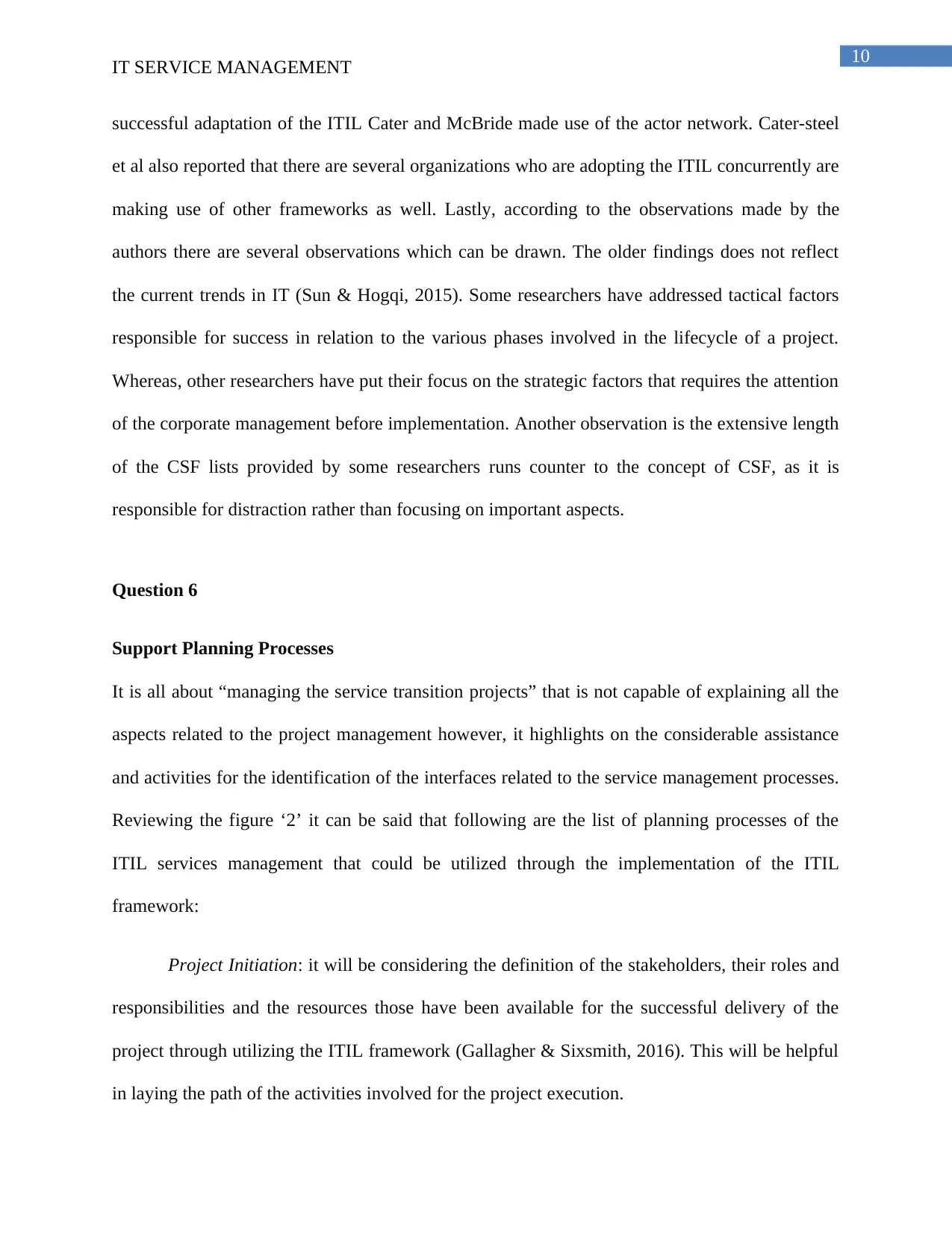
10
IT SERVICE MANAGEMENT
successful adaptation of the ITIL Cater and McBride made use of the actor network. Cater-steel
et al also reported that there are several organizations who are adopting the ITIL concurrently are
making use of other frameworks as well. Lastly, according to the observations made by the
authors there are several observations which can be drawn. The older findings does not reflect
the current trends in IT (Sun & Hogqi, 2015). Some researchers have addressed tactical factors
responsible for success in relation to the various phases involved in the lifecycle of a project.
Whereas, other researchers have put their focus on the strategic factors that requires the attention
of the corporate management before implementation. Another observation is the extensive length
of the CSF lists provided by some researchers runs counter to the concept of CSF, as it is
responsible for distraction rather than focusing on important aspects.
Question 6
Support Planning Processes
It is all about “managing the service transition projects” that is not capable of explaining all the
aspects related to the project management however, it highlights on the considerable assistance
and activities for the identification of the interfaces related to the service management processes.
Reviewing the figure ‘2’ it can be said that following are the list of planning processes of the
ITIL services management that could be utilized through the implementation of the ITIL
framework:
Project Initiation: it will be considering the definition of the stakeholders, their roles and
responsibilities and the resources those have been available for the successful delivery of the
project through utilizing the ITIL framework (Gallagher & Sixsmith, 2016). This will be helpful
in laying the path of the activities involved for the project execution.
IT SERVICE MANAGEMENT
successful adaptation of the ITIL Cater and McBride made use of the actor network. Cater-steel
et al also reported that there are several organizations who are adopting the ITIL concurrently are
making use of other frameworks as well. Lastly, according to the observations made by the
authors there are several observations which can be drawn. The older findings does not reflect
the current trends in IT (Sun & Hogqi, 2015). Some researchers have addressed tactical factors
responsible for success in relation to the various phases involved in the lifecycle of a project.
Whereas, other researchers have put their focus on the strategic factors that requires the attention
of the corporate management before implementation. Another observation is the extensive length
of the CSF lists provided by some researchers runs counter to the concept of CSF, as it is
responsible for distraction rather than focusing on important aspects.
Question 6
Support Planning Processes
It is all about “managing the service transition projects” that is not capable of explaining all the
aspects related to the project management however, it highlights on the considerable assistance
and activities for the identification of the interfaces related to the service management processes.
Reviewing the figure ‘2’ it can be said that following are the list of planning processes of the
ITIL services management that could be utilized through the implementation of the ITIL
framework:
Project Initiation: it will be considering the definition of the stakeholders, their roles and
responsibilities and the resources those have been available for the successful delivery of the
project through utilizing the ITIL framework (Gallagher & Sixsmith, 2016). This will be helpful
in laying the path of the activities involved for the project execution.
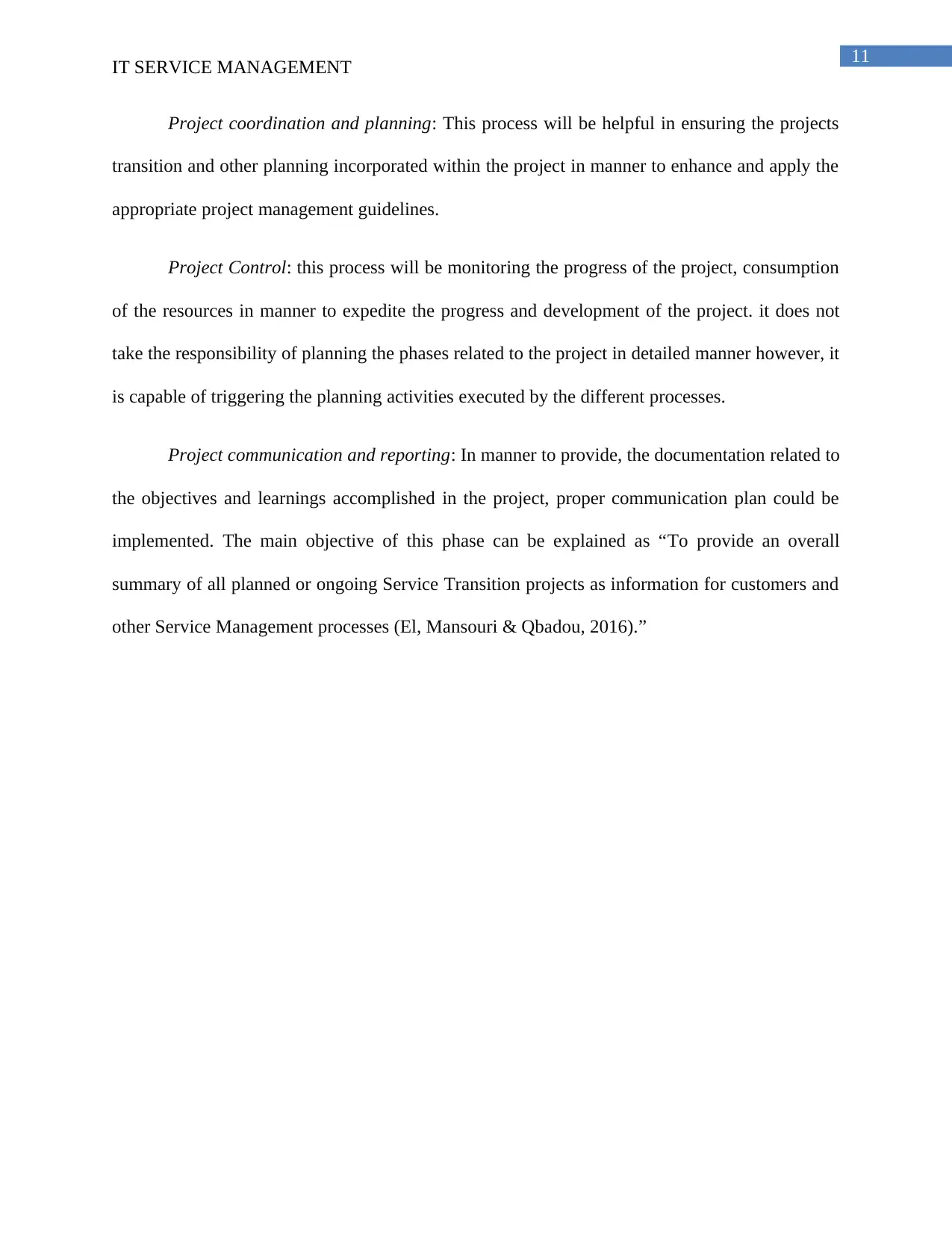
11
IT SERVICE MANAGEMENT
Project coordination and planning: This process will be helpful in ensuring the projects
transition and other planning incorporated within the project in manner to enhance and apply the
appropriate project management guidelines.
Project Control: this process will be monitoring the progress of the project, consumption
of the resources in manner to expedite the progress and development of the project. it does not
take the responsibility of planning the phases related to the project in detailed manner however, it
is capable of triggering the planning activities executed by the different processes.
Project communication and reporting: In manner to provide, the documentation related to
the objectives and learnings accomplished in the project, proper communication plan could be
implemented. The main objective of this phase can be explained as “To provide an overall
summary of all planned or ongoing Service Transition projects as information for customers and
other Service Management processes (El, Mansouri & Qbadou, 2016).”
IT SERVICE MANAGEMENT
Project coordination and planning: This process will be helpful in ensuring the projects
transition and other planning incorporated within the project in manner to enhance and apply the
appropriate project management guidelines.
Project Control: this process will be monitoring the progress of the project, consumption
of the resources in manner to expedite the progress and development of the project. it does not
take the responsibility of planning the phases related to the project in detailed manner however, it
is capable of triggering the planning activities executed by the different processes.
Project communication and reporting: In manner to provide, the documentation related to
the objectives and learnings accomplished in the project, proper communication plan could be
implemented. The main objective of this phase can be explained as “To provide an overall
summary of all planned or ongoing Service Transition projects as information for customers and
other Service Management processes (El, Mansouri & Qbadou, 2016).”
⊘ This is a preview!⊘
Do you want full access?
Subscribe today to unlock all pages.

Trusted by 1+ million students worldwide
1 out of 15
Related Documents
Your All-in-One AI-Powered Toolkit for Academic Success.
+13062052269
info@desklib.com
Available 24*7 on WhatsApp / Email
![[object Object]](/_next/static/media/star-bottom.7253800d.svg)
Unlock your academic potential
Copyright © 2020–2025 A2Z Services. All Rights Reserved. Developed and managed by ZUCOL.





